
About Ranthambore National Park Full Information Best Time to Visit
- 1 About Ranthambore National Park
- 2 Why Ranthambore Famous?
- 3 How to Reach Ranthambore?
- 4 Best Time to Visit Ranthambore
- 5 Monthly Weather in Ranthambore
-
6
Best Places to Visit in Ranthambore National Park
- 6.1 1. Ranthambore Jungle Safari
- 6.2 2. Ranthambore Fort
- 6.3 3. Padam Talao & Jogi Mahal
- 6.4 4. Rajbagh Talao & Ruins
- 6.5 5. Rajiv Gandhi Regional Museum Of Natural History
- 6.6 6. Kachida Valley Ranthambore
- 6.7 7. Bakula Wildlife in Ranthambore
- 6.8 8. Malik Talao Ranthambore
- 6.9 9. Shri Chamatkar Ji Temple
- 6.10 10. Lakarda and Anantpura Ranthambore
About Ranthambore National Park
According to Wikipedia Ranthambore National Park or Ranthambore is a national park in northern India, covering 282 km². Ranthambore was established as the Sawai Madhopur Game Sanctuary in 1955 by the Government of India. And was declared one of the Project Tiger reserves in 1973. Ranthambore became a national park on 1 November 1980. In 1984, the adjacent forests were declared the Sawai Man Singh Sanctuary and Keladevi Sanctuary. And in 1991 the tiger reserve was enlarged to include the Sawai Man Singh and Keladevi sanctuaries.
Ranthambore wildlife sanctuary is known for its Bengal tigers and is a popular place in India to see these animals in their natural jungle habitat. Tigers can be easily spotted even in the daytime.
Why Ranthambore Famous?
Ranthambore National park is spread over an area of 392 sq km. along with its nearby sanctuaries like – the Mansingh Sanctuary and the Kaila Devi Sanctuary. The park is majorly famous for its tigers and is one of the best locations in India to see the majestic predators in its natural habitat.
How to Reach Ranthambore?
By Air: Jaipur is the nearest airport for Ranthambore National Park. The Park is located just 180 km away from Jaipur city. One can hire cabs or avail bus services to reach the park.
By Rail: The nearest major railway station is Sawai Madhopur which is well connected to other major cities across India. One can hire a cab or avail the frequent private/public bus services from Sawai Madhopur to reach Ranthambore National Park.
By Road: Ranthambore National Park is located just 11 km away from Sawai Madhopur and plenty of buses ply between Sawai Madhopur and the park. You can also hire cabs or taxis from Sawai Madhopur to reach your destination.
Best Time to Visit Ranthambore
Ranthambore National Park remains open from the months of October to June, with the winter months (October – December) being the best time to visit this place. October to April are the best months to visit Ranthambore to spot tigers. Summers are quite hot, however, chances of spotting tigers increase in the summers. The park remains closed during monsoons.
Monthly Weather in Ranthambore
| Month | Avg. Minimum (°C) | Avg. Maximum (°C) |
|---|---|---|
| January | 10 | 22 |
| February | 13 | 27 |
| March | 18 | 32 |
| April | 25 | 40 |
| May | 28 | 41 |
| June | 28 | 39 |
| July | 27 | 33 |
| August | 25 | 31 |
| September | 25 | 34 |
| October | 22 | 34 |
| November | 15 | 30 |
| December | 12 | 27 |
Best Places to Visit in Ranthambore National Park
To let you enjoy the best, we’ve created this list of places to visit in Ranthambore which have to be in your itinerary! So, let’s begin.
1. Ranthambore Jungle Safari
 One of the best places to experience a wildlife safari in India is the Ranthambore Tiger Safari. Although tiger spotting is the prime attraction here, one can also spot jackal, fox, leopard, and mongoose. Embarking on a jungle safari to this tiger reserve lets you witness the nilgai, blue bull antelope, chital and sambar deer. Apart from the fauna, the flora too is worth admiring here. The landscape is defined by rolling hills and crags, lakes and rivulets. Ranthambore offers the best forest tours in India to visit the Tigers.
One of the best places to experience a wildlife safari in India is the Ranthambore Tiger Safari. Although tiger spotting is the prime attraction here, one can also spot jackal, fox, leopard, and mongoose. Embarking on a jungle safari to this tiger reserve lets you witness the nilgai, blue bull antelope, chital and sambar deer. Apart from the fauna, the flora too is worth admiring here. The landscape is defined by rolling hills and crags, lakes and rivulets. Ranthambore offers the best forest tours in India to visit the Tigers.2. Ranthambore Fort
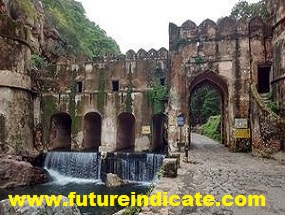 Ranthambore Fort lies within the Ranthambore National Park, near the town of Sawai Madhopur, the park being the former hunting grounds of the Maharajahs of Jaipur until the time of India’s Independence. It is a formidable fort having been a focal point of the historical developments of Rajasthan.
Ranthambore Fort lies within the Ranthambore National Park, near the town of Sawai Madhopur, the park being the former hunting grounds of the Maharajahs of Jaipur until the time of India’s Independence. It is a formidable fort having been a focal point of the historical developments of Rajasthan.
The mighty powerful fort of Ranthambore has seen an immense number of attacks and conquests. The fort was the major barrier for the invaders because of the difficulty they faced to capture and the well-planned construction of the fort. The Ranthambore Fort is situated inside the Ranthambore National Park which was the hunting grounds for the Maharajas of the Jaipur dynasty. It is located in the town of Sawai Madhopur in Jaipur.
Note:- Ranthambore Fort can be visited separately without any permission by hiring a private cab or own vehicle. To reach the top of the fort from the main entrance, one needs to climb 600 odd steps.
Timings: 8 AM to 5 PM
3. Padam Talao & Jogi Mahal
 At a distance of 500 m from Ranthambore Fort, and 5 km from Ranthambore National Park Entry Gate, the Padam Talao is a large and beautiful lake situated inside Ranthambore National Park. It gets its name from the lotus flowers that bloom in the lake. The Padam Talao is a favorite watering hole of the animals of Ranthambore. Tigers, Leopards, Deer, Monkeys, and Peacocks can be seen drinking at the lake’s edge during the early morning and late evening.
At a distance of 500 m from Ranthambore Fort, and 5 km from Ranthambore National Park Entry Gate, the Padam Talao is a large and beautiful lake situated inside Ranthambore National Park. It gets its name from the lotus flowers that bloom in the lake. The Padam Talao is a favorite watering hole of the animals of Ranthambore. Tigers, Leopards, Deer, Monkeys, and Peacocks can be seen drinking at the lake’s edge during the early morning and late evening.
Machans or huts on observation posts near the Padam Talao are an excellent platform from where visitors can see the animals in their natural habitat. Genghis, one of the legendary Tigers of Ranthambore was famous for hunting deer that came to the lakeside to drink.
The hunting lodge called Jogi Mahal is situated on the banks of the Padam Talao. The view from the Jogi Mahal is a splendid one. Jogi Mahal was built by the royal families of Jaipur and served as a hunting abode to various generations of Jaipur Maharajas. After the decline of the ruling authorities of Jaipur, this Mahal is turned into a guest house that offers a comfortable stay to tourists during their visit to Ranthambore.
Note:- Timings: 6 AM – 5 PM
4. Rajbagh Talao & Ruins
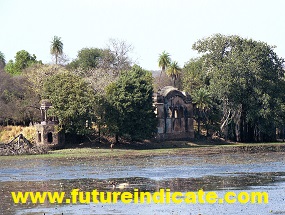 At a distance of 1 km from Padam Talao, 1.5 km from Ranthambore Fort and 6 km from Ranthambore National Park Entry Gate, Rajbagh Talao is the most fascinating of the three large lakes in Ranthambore National Park other two are Padam Talao and Malik Talao.
At a distance of 1 km from Padam Talao, 1.5 km from Ranthambore Fort and 6 km from Ranthambore National Park Entry Gate, Rajbagh Talao is the most fascinating of the three large lakes in Ranthambore National Park other two are Padam Talao and Malik Talao.
The Rajbagh Talao is an important source of food and water for many of the herbivorous inhabitants of Ranthambore. The major attractions of the place are the animals that seem to always flock to its waters and also see the large population of animals and birds feeding in it. The lake is partially covered with marshy plants. Sambar, Chital, Nilgai, and Blackbuck are seen drinking alongside, peacocks, and wild boar. Tigers are often seen stalking the deer that come to drink and feed in the Rajbagh Talao.
The Rajbagh ruins located along the banks of the lake add to its exotic ambiance. The ruins of these structures consist of broken-down rooms and outhouses with arches, partly standing walls and domes. The majestic tigers of Ranthambore can be seen relaxing in the shade of these structures in Ranthambore National Park. These ruins are what give the Ranthambore National Park such a unique mixture of a wildlife reserve and a reminder of the past, which together make it one of the most picturesque parks in the world.
5. Rajiv Gandhi Regional Museum Of Natural History
 At a distance of 3.5 km from Ranthambore National Park and 6.5 km from Sawai Madhopur Railway Station, the Rajiv Gandhi Regional Museum of Natural History is a museum situated at Ramsinghpura village of Sawai Madhopur in Rajasthan. It is the fourth Regional Museum of Natural History in India after Mysore, Bhopal, and Bhubaneswar.
At a distance of 3.5 km from Ranthambore National Park and 6.5 km from Sawai Madhopur Railway Station, the Rajiv Gandhi Regional Museum of Natural History is a museum situated at Ramsinghpura village of Sawai Madhopur in Rajasthan. It is the fourth Regional Museum of Natural History in India after Mysore, Bhopal, and Bhubaneswar.
The honorable Vice President of India, Hamid Ansari laid the foundation of Rajiv Gandhi Regional Museum of Natural History in December 2007 and was inaugurated in 2014. The museum was undertaken by the Ministry of Environment and Forests, Government of India. Spread in 7.2 acres of land, the museum is tastefully designed and aims at creating awareness of diverse life on earth.
There are three floors in the museum, with exhibits on plants, livestock, mineral resources and geology of the western region and western dry area of India. As if now, only the ground floor is operational with a well-laid exhibition on the wildlife in Ranthambore and the famed Ranthambore Fort. The main visitor attractions are the facsimile of animals such as chinkara, leopard, lion, and tiger.
There are village dioramas of the Bishnoi community and Rajasthan rural area. The museum also has a pottery stall and an art gallery, where visitors can witness live pottery making and painting. These items are available for sale as well.
There is a library in a hall opposite the reception area, where visitors can read books on the wildlife of western India, biodiversity of Rajasthan and more. The museum is likely to provide educational and extracurricular activities for schools while depicting the understanding or interrelationship between plants and animals. The museum has appointed two naturalists to assist visitors. An auditorium accommodating 300 people has also been constructed for deliberate seminars and wildlife documentary presentations.
Note:- Timings: 10 AM to 5 PM on all days except on Mondays and National Holidays – Entry: Free
6. Kachida Valley Ranthambore
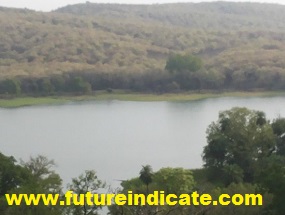 At a distance of 13 km from Ranthambore National Park, Kachida Valley is situated in the outer region of Ranthambore National Park in Rajasthan. It is one of the popular zones for a jeep safari in the park.
At a distance of 13 km from Ranthambore National Park, Kachida Valley is situated in the outer region of Ranthambore National Park in Rajasthan. It is one of the popular zones for a jeep safari in the park.
Enclosed by low jagged hills, and dotted by revitalizing greenery, Kachida Valley is one of the picturesque and a must-visit place in Ranthambore. It is blessed with a wide range of flora and fauna species. This area contains a majority of the Panther population of the park. The Panthers avoid venturing into the main jungle to avoid conflicts with tigers, which are known to kill them. Tourists can also see a variety of sloth bears and deer in this valley. Visitors will have to reach this valley via the jeep safari.
7. Bakula Wildlife in Ranthambore
 At a distance of 16 km from Ranthambore National Park Entry Gate, Bakaula or Bakhola is one of the many regions inside Ranthambore National Park.
At a distance of 16 km from Ranthambore National Park Entry Gate, Bakaula or Bakhola is one of the many regions inside Ranthambore National Park.
Bakula is amongst the coolest places in the Ranthambore area due to its dense populace of trees and many water holes, small pools and other water bodies that are scattered in plenty here. The thick vegetation also retains moisture in the air and lowers the temperature of this area. Because of the excellent forest cover and availability of water, the Bakaula region in Ranthambore National Park has an abundance of wildlife like birds, squirrels, mongoose, and monkeys. This region is also famous for many lions and one can often spot mummy tigers with their cubs roaming around leisurely.
Note:- Tourists can visit this place only as part of wildlife safari.
8. Malik Talao Ranthambore
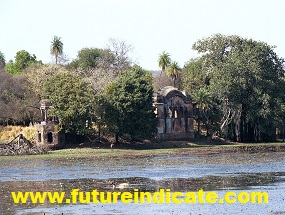 Malik Talao is best known as a haven for birds and it attracts a large number of visitors. The lake is quite important to the wildlife of the park as it serves as the source of water and food for the animals and birds inhabited there. This small yet scenic lake is also home to the Marsh Crocodiles. Herds of wild boar and groups of peacocks, eagles and various migrated birds can be seen browsing along the banks of the lake. Kingfishers, egrets, herons, ibis, storks, and cranes are some of the commonly spotted birds at Malik Talao making it the perfect place for bird watching in Ranthambore.
Malik Talao is best known as a haven for birds and it attracts a large number of visitors. The lake is quite important to the wildlife of the park as it serves as the source of water and food for the animals and birds inhabited there. This small yet scenic lake is also home to the Marsh Crocodiles. Herds of wild boar and groups of peacocks, eagles and various migrated birds can be seen browsing along the banks of the lake. Kingfishers, egrets, herons, ibis, storks, and cranes are some of the commonly spotted birds at Malik Talao making it the perfect place for bird watching in Ranthambore.
Note:- Tourists can visit this lake during their Jungle safari only.
9. Shri Chamatkar Ji Temple
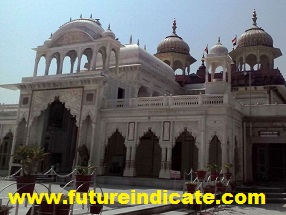 The Chamatkar Ji Temple has been named so because of a number of fascinating miracles were linked to its foundation. According to history, this temple belonged to a simple farmer who had found God’s idol when he dug up a particular place in the field after being directed by God in his dream. The idol was given over to the Jain Digambaras. The legend further goes to say that the same farmer was again told by God in his dream to place the idol in a chariot and leave it to see where the horse refuses to move further. That place was chosen as the site of the temple. Thus Chamatkar Temple came to be built in Sawai Madhopur.
The Chamatkar Ji Temple has been named so because of a number of fascinating miracles were linked to its foundation. According to history, this temple belonged to a simple farmer who had found God’s idol when he dug up a particular place in the field after being directed by God in his dream. The idol was given over to the Jain Digambaras. The legend further goes to say that the same farmer was again told by God in his dream to place the idol in a chariot and leave it to see where the horse refuses to move further. That place was chosen as the site of the temple. Thus Chamatkar Temple came to be built in Sawai Madhopur.
Sri Chamatkarji Mandir is a huge ancient and beautiful temple decorated with artistic spires and umbrellas. This 400-year-old temple has two altars. The front altar has the dark red stone idol of Lord Padmaprabhu in sitting position. A few more idols of other Tirthankaras can be seen around this.
In the rear altar, a 6-inch high idol of Lord Adinath in padmasana posture is there. One can also see a number of striking idols of Jain Tirthankaras (24 gurus of Jains) here. It is strongly believed by the thousands of Jain pilgrims who come here every year that all their wishes are positively fulfilled here.
Note:- Timings: 5 AM to 10 PM
10. Lakarda and Anantpura Ranthambore
 Lakarda and Anantpura are located in the north-western and northern regions of Ranthambore National Park. These regions are known for their teeming population of Sloth bears as various sources of food like honeycomb and fresh fruits are available for them. Several species of monkeys and porcupines can also be spotted in the region making it a must-visit spot for the wildlife enthusiasts and shutterbugs.
Lakarda and Anantpura are located in the north-western and northern regions of Ranthambore National Park. These regions are known for their teeming population of Sloth bears as various sources of food like honeycomb and fresh fruits are available for them. Several species of monkeys and porcupines can also be spotted in the region making it a must-visit spot for the wildlife enthusiasts and shutterbugs.
It is one of those few places in this wildlife reserve, where the pugmarks of the Indian striped Hyenas can be seen. This species of hyena has a very small population in the jungle and Lakarda and Anantpura are amongst those few spots where there is a possibility of sighting these otherwise rare species.
Note:- Morning is the best time to explore this hill in Ranthambore and study the natural lifestyle of the sloth bears. Tourists can visit Lakarda and Anantpura regions as part of Ranthambore Jungle Safari only.
Read Also- About to Jaipur City Guide



More Stories
Jaipur Information and City Guide to Plan Your Trip